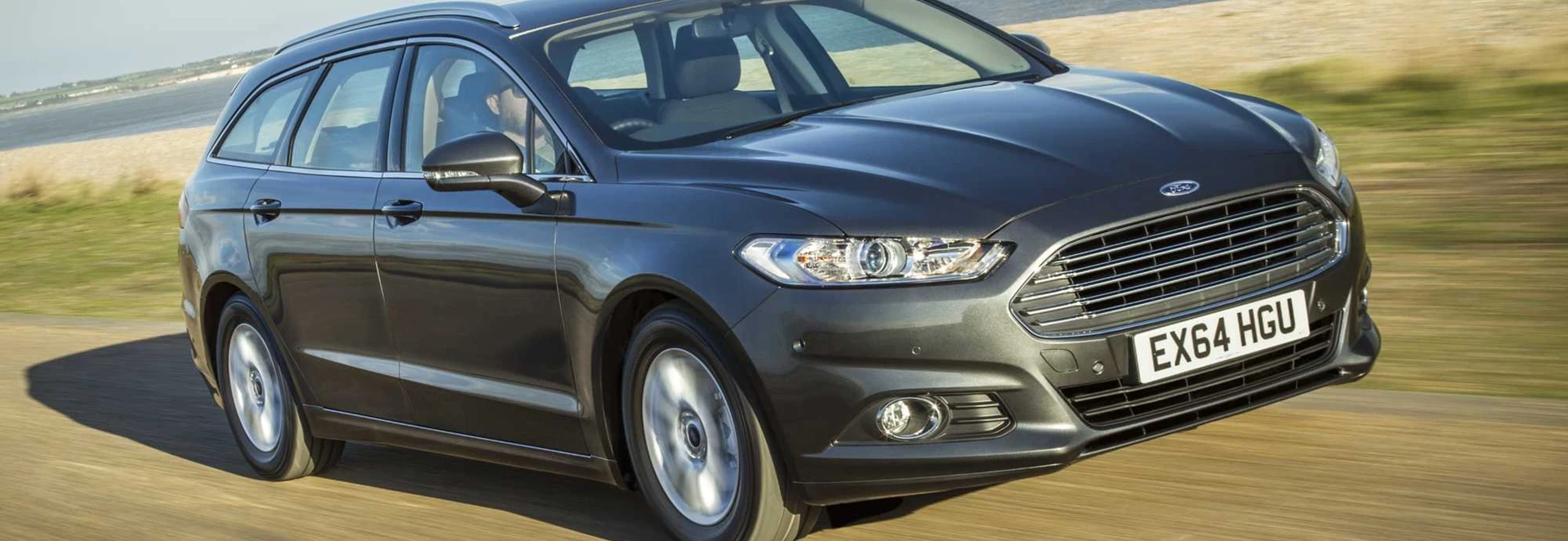Ford launched the 2015 Mondeo Estate at the same time as the four-door saloon and five-door hatchback variants. Like them, it has quite different styling from the previous model, most notably a front grille which is characteristic of current Fords and becoming gradually less often compared to that of an Aston Martin. Few would deny that this version looks more elegant than any of its predecessors. The interior is also the best yet.
The Estate is a large car, though with less interior room than some of its rivals, and it's offered in three trim levels and with a wide variety of petrol and diesel engines. A choice of manual and automatic gearboxes is available in most cases. The petrol-electric hybrid powertrain is one of the few in the Mondeo range that you can't have in the Estate.
Performance
Extra weight and slightly inferior tail-end aerodynamics make the Estate slower than the hatch, but there's not much in it. The quickest version is the 237bhp 2.0 turbo petrol EcoBoost, which has a 0-62mph time of 8.0 seconds and can reach 146mph, though it isn't likely to be a big seller.
Among the more popular diesels the fastest is the 2.0 TDCi diesel manual, whose equivalent figures are 8.4 seconds and 137mph with manual transmission or 8.7 seconds and 135mph in automatic form. Nearly all the others have 0-62mph times of 10 seconds or better and can achieve at least 129mph. The exception is the high-economy 114bhp 1.6 diesel, which lags behind quite significantly on 12.3 seconds and 116mph.
Dreary as this may sound, this engine suits the car well, and its decent mid-range performance means that it doesn't feel slow unless you're in a big hurry. Excellent noise insulation means that the Estate remains quiet even when being pushed hard. In manual versions, the gearchange and clutch actions make smooth shifts very easy.
Ride and Handling
Larger wheels, particularly the 19s available as an option for the range-topping Titanium, improve the appearance but make the ride too bumpy
As has been the case with Mondeos for many years, you have a choice between dramatic looks and good ride quality. Larger wheels, particularly the 19s available as an option for the range-topping Titanium, improve the appearance but make the ride too bumpy. On the less attractive 16s (the smallest on offer) it's very good. The downside is that this Ford, like most of the others introduced recently, is too soft at the front. The pitching motion that results even on small bumps is very unfortunate, because if Ford made the suspension very slightly firmer the car would stand comparison with much more expensive vehicles as a long-distance cruiser.
Interior and Equipment
Ford first used the Mondeo name in 1992 and has persisted with it despite suggestions that the term 'Mondeo man' has harmed its UK sales.
If you're going to buy this car instead of a Mondeo saloon or hatch, luggage volume is presumably important to you. With the rear seats in place the Estate is actually inferior to the hatch, with a volume of 500 litres as opposed to 541, but when those seats are folded down the Estate romps ahead with 1,605 rather than 1,437 litres. This will be enough for most people, and it's more space than you get in a Vauxhall Insignia Sports Tourer. But if you need more you'll prefer the estate versions of the Skoda Superb and Volkswagen Passat, both of which are significantly roomier. The interior is better designed than that of the previous Mondeo. The improvement of the graphics in particular is outstanding. The lowest trim level, called Style, is not popular in any Ford range. You're more likely to buy the Zetec or Titanium, both of which have DAB digital radio, dual-zone air-conditioning, a rear-seat "ski hatch", cruise control, the SYNC 2 connectivity system, roof rails and a heated windscreen. Titanium specification includes satellite navigation, sports seats, traffic sign recognition and automatic headlights and wipers.
Cost
Combined fuel economy is officially 74.3mpg and, while that would be very difficult to match, in practice 50mpg is easy and 60mpg not too tricky
Remarkably, Ford has been able to create a non-hybrid version of this large car with CO2 emissions of under 100g/km. The 1.6 TDCi ECOnetic achieves 99g/km, so you don't have to pay any Vehicle Excise Duty and the Benefit In Kind rating for business users will not exceed 20 per cent this side of 2019. Combined fuel economy is officially 74.3mpg and, while that would be very difficult to match, in practice 50mpg is easy and 60mpg not too tricky. Other diesels in the range have EU test figures of 56.5mph and 130g/km or better. 1.5-litre petrol EcoBoost models are far less economical than the 2-litre diesels (which have similar performance in 148bhp form) and are only trivially cheaper to buy. The 2.0 EcoBoost can't beat 40mpg even in laboratory conditions and has CO2 emissions of over 170g/km, making it the most expensive model to tax by a long way.
Our Verdict
Unless you're on particularly good terms with your local Ford dealer and wouldn't consider buying a car from anyone else, the Mondeo should not be the only thing on your shopping list if you're in the market for a large, non-premium estate. The opposition is very good, and in several cases offers more practicality. That said, the Mondeo is a handsome car with decent load space and, usually, excellent road behaviour. A diesel engine is the obvious under-the-bonnet choice, the 1.6-litre being quite sufficient unless you really want the extra performance of the larger ones.




